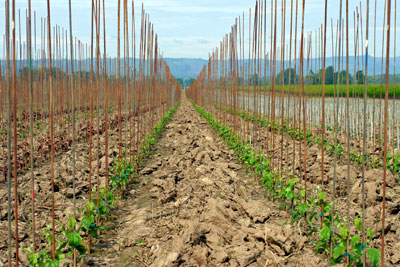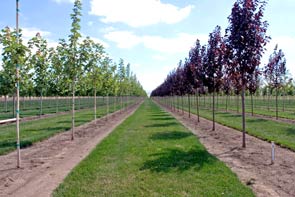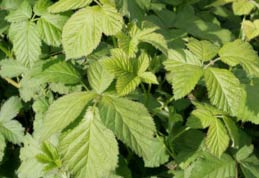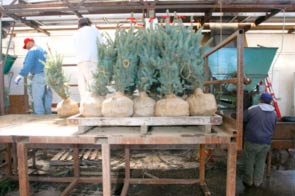Wholesale Nursery Site Selection

on Sauvie Island west of Portland Oregon
The time spent selecting the right spot for a wholesale field or container nursery will be rewarded by strong plant growth, and ease of management. If it takes a number of months to find an ideal site the prospective horticulturist will have had the time to review a number of different parcels at different times during the year and will have been able to employ a number of important selection tools. With agricultural land preservation efforts in the Pacific Northwest there should be suitable parcels for either purchase or rent in most areas.
Location, Location, Location
As with any assessment of real estate, look for nursery land that is suitable by the customer base it will serve. With the exception of mail order operations, wholesale nurseries that will produce field run, container, pot-in-pot, or greenhouse stock should be in fairly close proximity to the population center where the plants will be distributed. The availability of major highways nearby should be assessed. As with any other freight, nursery stock moves by over-the-trailer tractor-trailer units. With the perish ability of nursery stock, the time and distance it is moved has to be considered in the expense to profit calculation.
As the nursery industry has been expanding all across North America producers will have to seek out markets closer to the production unit in order to achieve the highest return on investment. Over the 1993–2002 time frame the U.S. Department of Agriculture’s Economic Research Service reported a 43% increase in total value of wholesale nursery stock production (1). In 1999 the Oregon Association of Nurseries reported that 40% of the state’s nursery stock was shipped to the northeast, upper mid-west, and the Atlantic states (2). With the expanding industry and higher transportation costs, seeking markets closer to the Northwest will be ever more important.
Western North American Wholesale Nurseries

The bulk of the nurseries in the western regions of North America have situated themselves west of the Sierra Nevada and Cascade mountain ranges in order to capitalize on the milder weather conditions, proximity to population centers, and ready access to major highway systems. With as many as 270 frost free days in the northwest region of Oregon, and lack of harsh winters, plant growth is excellent. The USDA Hardiness Zone map (3) shows that Zone 7A, with its associated minimum winter temperatures of 0° F to 5° F, extends from northern California, near Redding, north along Interstate 5 all the way into southern British Columbia. All along this zone of mild climate are situated tree, shrub, ground cover, Christmas tree, bulb, turf, and floriculture nurseries. Wholesale nurseries have prospered by capitalizing on the availability of relatively flat, fertile ground; abundant winter rain; a good supply of agricultural labor; good transportation access; and expanding population bases.
It Begins with the Soil
Appraising a site for a future wholesale nursery involves more than simply driving by a vacant parcel of ground. The best assessment comes with walking the property, reviewing soils maps, observing the native vegetation, and talking with nearby owners. If possible try to locate an aerial photo of the property as well. It’s best to determine if there are other nurseries nearby and ask for a tour to review the species being produced.
The ideal site consists of gently rolling, fertile, stone-free ground with excellent soil drainage (4). For field planting, slopes of 2–5% are preferable (5). Completely level sites may not drain well, where-as slopes over 5% tax workers and machinery as well as can contribute to soil erosion. As field grown stock takes as long as 8 years to mature (caliper shade trees from seed or cutting to finished stock), knowing the soil drainage is imperative. If the roots of perennial crops are flooded during the winter months the tops of the plants will suffer greatly. While there are wetland species that will tolerate some soil flooding (silver maple, green ash, others; see 6) in general the better the drainage the better the plant vigor.
It can be hard to assess the soil drainage characteristics during the dry, summer months in the Pacific Northwest. With the near absence of summer rainfall the wet spots that show up in the winter usually look fine during the summer. It’s better to identify the location of the parcel using a road atlas and a soils map provided by the U.S. Natural Resources Conservation Service (7). A soils map should be available for every county in the Northwest. It will show the soil type, depth, depth of hard pan if there is one, ability to drain, ability to supply moisture, ease of tillage, and response to lime and fertilizer. The best sites have well-drained soil depths of 18”-24”. In digging field stock with tree spades, a practice which has now replaced hand digging balled and burlapped stock, the American Standards for Nursery Stock has set standards for both the root ball diameter as well as the root ball depth. For example, a 2” caliper shade tree would be required to have a 24” diameter root ball diameter with an associated 16” root ball depth. For a landscaper looking for a specimen 3” caliper tree, the root ball diameter and depth would be 30” and 19”, respectively. Thus the more lucrative shade trees will require deeper soil types.
A Range of Soil Types

Nurseries can be established on many different soil types, including clay loams, loams, and sandy loams (9). Common shade tree species such as maples, birch, oak, and ash occur all across America on many different sites. Still, a relatively broad expanse of one contiguous soil type is best for field grown stock as it avoids having to deal with the wetting and drying characteristics of different soil types. By all means avoid hydric soils, or those that are sufficiently wet in the upper part to develop anaerobic conditions during the growing season. If a soils map is not readily available, soil drainage can be assessed by digging holes in the prospective site and testing water infiltration rates. Dig holes 18” deep. Fill the holes with a pail full of water. After the water has drained away, fill the holes again. If water from the second pail has not drained away after 24 hours the site has serious soil drainage problems (5). Sites with these types of drainage problems should either be avoided or considered as potential candidates for the installation of sub-surface drain tile systems. Installing a drain tile system can be moderately expensive for field grown stock, but very expensive for pot-in-pot production.
Container Operations
Container nursery growers don’t have to be as selective as field growers in the choice of soil type as their operations are established above ground using container growing mixtures as opposed to native soil. None-the-less, sites with poor drainage can interfere with machinery travel during the wet months of the year. If the site consists of a clay soil type, and puddling occurs readily after a heavy rain or irrigation set, a slope of 5% is desirable (10). The extra slope may reduce the need for extensive container bed grading, extensive use of gravel, or the installation of a sub-surface drain tile system. Slopes over 5% present challenges for setting pots. Rows of pots should be arranged so as to follow the contour of the slope. Grassed roadways between the blocks of rows will help reduce runoff.
In the past sandy sites had to be avoided as well. When hand digging balled and burlapped stock the root balls often collapsed. A modern mechanical tree spade, using three or four hydraulic blades, can now be used to dig up a cone of soil and roots, which are then placed in a wire basket, lined with burlap and pinned with nursery twine and nails. Since the advent of sophisticated tree spades in the early 1980’s, all sorts of ground that was previously unsuitable to field production has now become usable.
Proximity to Streams
Pacific Northwest farmers with properties abutting streams and rivers have come under increasing environmental pressure during the last 20 years as concern over native fish populations, and agricultural run-off have increased. From the federal level the U. S. Environmental Protection Agency has set forth a number of initiatives aimed at protecting our nation’s watersheds (11), as well as endangered species (12). Using a whole system approach to watershed protection, including reducing storm water run-off from roads, stream buffers to reduce run-off from homes and farms, and planting non-invasive vegetation along water courses, the EPA has a long term plan for improving our nation’s water courses. The states are mandated to partner with the EPA to share the costs associated with watershed restoration and preservation.
Ornamental producers must recognize the impacts these federal and state programs may have on the future of farming activities near water courses and plan accordingly. On the East coast of the United States, 50’ riparian buffers are suggested as the best method of protecting streams, and rivers from agricultural runoff (4). In the Pacific Northwest agricultural buffer widths to protect salmon bearing streams are still being formulated. The Washington State Department of Ecology is the regulatory agency responsible for protecting watersheds from non-point source pollution (13). In Oregon the Department of Environmental Quality (DEQ; see 14) administers a similar program known as the Non-point Source Control Program Plan (15) to meet the requirements of the federal Clean Water Act, passed by Congress in 1972.
Previous Cropping History
In assessing the feasibility of purchasing or leasing a piece of ground for a field grown nursery it is most helpful to know about the prior cropping history. If the previous crop was treated with residual herbicides, such as with the chemicals known as the triazines (Atrazine, Simazine,) or the substituted urea herbicides (such as linuron and diuron), there may be carry-over residues that could harm the growth of young ornamental plants (16). While these residues do not last forever, and there ways to deactivate them, their presence should be noted and considered when determining the suitability of different parcels of ground for a field grown nursery.
If the previous crop was brush or timber it generally takes a year of clearing, plowing, disking, and cover crops to return the site to field bed conditions for planting seedlings, pot-in-pot, or fabric containers. Any remnants of the root systems need to have been totally dug up and hauled out or disked under and decomposed before the field can be replanted to young nursery stock. Essentially the site has to be returned to seed-bed condition as if the field were to be planted to small grains or vegetables.
Perennial Weeds

Pastures or former timber ground can be invested with perennial weeds that will need to be totally eliminated prior to planting any type of outdoor nursery crop. In the Northwest be aware of fields with heavy infestations of nutsedge, Canada thistle, Scotch broom, reed canary grass, tansy ragwort, bracken fern, blackberries, and field bindweed. Fields with tough to control perennial weeds such as these require applications of over all herbicides as well as pre-plant cover crops. Refer top the PNW Weed Control Handbook (17) for herbicides choices that can be used to clean-up weedy pastures.
Road Access
Prospective nursery sites need to be accessible by good all-weather roads. As the majority of supplies and stock are shipped by over-the-road trailers, there should be no steep roads, sharp corners, weight-restricted bridges, or soft surfaces on access roads (18). A consultation with a road construction engineer may be called for when there are concerns over truck access. Most of the larger wholesale nurseries in the Willamette Valley of Oregon are located near the major highways, as 73% of the state’s nursery crops are exported out of the state (19).
Availability of Workers
The nursery industry is one of the most labor intensive agricultural enterprises in existence. Owners will need a permanent staff of full time workers for production management, shipping coordination, office support, and sales. In areas where there are other nurseries, or where there technical or university-trained workers in the vicinity, finding permanent staff is usually not all that difficult. Owners will have to offer benefit packages for the permanent staff to attract the best workers, as wages in the nursery industry are often lower than in other professions. If younger workers know that they have been assigned leadership positions, and can envision ways to advance, they will be more interested in maintaining company loyalty.

As many wholesale nurseries harvest and ship the bulk of their products over a relatively short time frame there is invariably the need for a larger temporary work force of semi-skilled labor. Once again, if there are other agricultural related industries in the area, this helps in the securing labor during the peak harvest and shipping times. Growers often work together to share seasonal laborers between themselves.
There is also the option of providing temporary worker housing to attract seasonal laborers. Contact the Washington State Department of Health for information on the Temporary Worker Housing program. For Oregon, consult with the Oregon Housing and Community Services program. In the Pacific Northwest the bulk of the labor force is of Hispanic origin. Many well established nurseries find that there is a very strong interest on the part of the Hispanic labor force to work at nurseries where the pay, steady employment, and quality of work can be better than other agricultural industries.
Agricultural Land Zoning
Wholesale nurseries are typically situated on rural land zoned as agriculture. In Washington the state legislature passed the Growth Management Act (GMA; see 20) of 1990 in order to preserve rural ground and to concentrate urban development within Urban Growth Boundaries. Individual counties are to set 20 year growth plans on how to preserve rural lands. One of the principal aims of the GMA act was to preserve agricultural industries within rural zones. Though not all of Washington’s 39 counties have yet to enroll in the GMA act, those that have are generally very aware of the importance of preserving farm ground. Land that is classified agricultural is considerably less expensive to purchase or lease than land considered urban. Ag land, as long as it shows an income from a farm enterprise, is taxed at a rate much lower than urban ground as well. County commissioners generally view traditional farming practices such as field plowing, weed control, brush cutting, pesticide spraying, and marketing in a much better light if the land is considered agricultural than if it is not.
Oregon’s Growth Management Efforts
Oregon enacted its acclaimed growth management law, the Land Conservation Act (LCA; see 21), in 1973. Its passage was a reaction to heavy suburban growth in the Willamette Valley and the state’s northwestern coastline with its accompanying problems (traffic congestion, air pollution, sewage pollution, etc.) during the 1960’s and early 1970’s. For the last thirty years the Oregon Department of Land Conservation and Development (DLCD; see 22) has proven to be very effective in preserving agricultural land throughout the state. Public support for this department has generally been very good. The city Portland, and other major cities throughout the state, have established well defined Urban Growth Boundaries, which have helped immeasurably to preserve rural property from urban encroachment. The national coalition known as Smart Growth America (23) has recognized Portland Oregon for its very good track record of protecting rural lands from urban sprawl. Many of the largest wholesale nurseries in Oregon are located right outside the Urban Growth Boundary (2) of Portland, OR. Without a state wide policy of controlling land use, these nurseries would be severely challenged by the pressures of urban development.
Access to Utilities
Nurseries will require electricity for lighting and operation of equipment, including irrigation pumps, potting machines, and office equipment. Three-phase power is preferable for larger equipment. For heating, natural gas is preferable over other energy sources (24). Greenhouse growers without access to natural gas often revert to liquid propane (LP) gas for convenience.
Room for Expansion

Prospective wholesale nursery producers should look beyond the confines of the land parcel they are appraising. If the business is successful for the first five years there is every reason to consider expansion. Once the basics of growing nursery stock have been mastered, and sales contacts have been built, it’s not all that difficult to consider expanding onto adjacent property. Neighboring property can be serviced by existing machinery and supplies without having to transport them to distant parcels. Adjacent property may very well be classified as agricultural as well. If it can not be purchased, the owner may be interested in leasing it. Rural landowners often prefer living near productive rural enterprises, as opposed to further housing units. By leasing out the unused parcel the landowner is spared the time and expense of maintaining it.
Future Development Plans
One of the benefits of the state-wide growth management programs in Oregon and Washington is being able to farm a piece of ground knowing that it is not going to be developed in the immediate future. County planning departments can provide long-range projections on the future plans for rural property. They often have projections on population increase, roads, sewers, gas lines, and other indicators of encroaching urban pressure. While retail nurseries can thrive within urban growth areas, wholesale nurseries typically can not. If there are plans to start out with a wholesale nursery but then move into retail, there is every reason to consider locating an operation on a small parcel near an urban growth boundary for one the Northwest’s major cities.
Prospective nursery owners should consult with state departments over the availability of school-tax ground for lease in Oregon and Washington. If it not being used for timber production as it was once designated for, it can often be suitable for agriculture.
References
- Floriculture and nursery crops outlook yearbook. November 2007. Alberto Jerardo. Markets and Trade Economics Division, Economic Research Service, U.S. Department of Agriculture, FLO-2007.
- Oregon nursery & greenhouse industry statistics, September 2006, Oregon Association of Nurseries, Wilsonville, OR.
- USDA plant hardiness zone map. 2003. United States National Arboretum. Web-based version USDA Miscellaneous Publication No. 1475, issued January 1990.
- Site selection and layout for plant nurseries. Ted Bilderback. Department of Horticultural Science, North Carolina State University.
- Starting a commercial nursery in Ontario. April, 2005. Chris Kessel. Ontario Ministry of Agriculture, Food, and Rural Affairs.
- Selection, production, and establishment of wetland trees and shrubs. 1999. Mel Garber and D. Moorhead, University of Georgia.
- Soils maps. United States Natural Resources Conservation Service, National Soil Survey Center, Lincoln, NE.
- American standards for nursery stock (AN Z 60.1), American Association of Nurserymen, Washington, D.C.
- Best management practices for field production of nursery stock. North Carolina State University Cooperative Extension.
- Container Nursery Design. 1986. Bonnie Lee Appleton, American Nurseryman Publishing Company, Chicago, IL.
- United States Environmental Protection Agency: Watersheds. Washington, D.C.
- Endangered Species Act, U.S. Environmental Protection Agency, Washington, D.C.
- Polluted runoff in Washington State. 2003. Washington State Department of Ecology, Water Quality Program, Olympia, WA.
- Oregon Department of Environmental Quality, Salem, OR.
- Non-point source pollution. 2007. Oregon Department of Environmental Quality, Salem, OR.
- Testing for and deactivating herbicide residues. 2007. Ray William, Oregon State University Department of Horticulture. In: PNW Weed Management Handbook, 2007.
- Weed control in pasture and rangeland. 2007. Bob Parker, Washington State University. In: Pacific Northwest Weed Control Handbook.
- The Container Tree Nursery Manual, Volume One: Nursery planning, development, and management. 1995. Tom Landis, Richard Tinus, Stephen McDonald, and James Barnett. U.S. Department of Agriculture Forest Service, Agricultural Handbook 674. Available through the U.S. Government Printing Office.
- Statistics. 2006. Oregon Association of Nurseries, Wilsonville, OR.
- Growth Management Act. 2007. Washington State Office of Community Development, Olympia, WA.
- Land Conservation Act, 2003. Oregon Department of Land Conservation and Development, Salem, OR.
- Department of Land Conservation and Development, Salem, OR.
- Smart Growth America. 2003. Washington, D.C.
- Structures and equipment for container plant production. 2000. Francis Joswik. In: The Greenhouse and Nursery Handbook. Andmar Press, Mills, Wyoming.
Our pages provide links to external sites for the convenience of users. WSU Extension does not manage these external sites, nor does Extension review, control, or take responsibility for the content of these sites. These external sites do not implicitly or explicitly represent official positions and policies of WSU Extension.